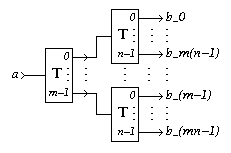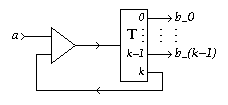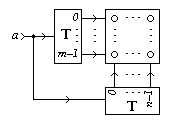. (Not available for general k)
Verdect
Parameterized definitions are not possible in VERDECT, but this sketch gives the general idea:Specification in Verdect:
define TOGGLE( a?, b0!, .., b(k-1)! ) =
pref *[ a?; b0!; .. ; a?; b(k-1)! ]
end
Also available through this linkDI Algebra
Pure DI Algebra does not allow a generalized specification. The following specification therefore needs instantiation before interpretation:Specification in DI Algebra:
T(k) = T(k,0) where T(k,i) = a?; bi!; T(k,(i+1) mod k)Also available through this link.
The specification of the case k=3 is as follows:
Specification in DI Algebra:
# Generated by expexp.pl
NAME ="T"
I = { a? }
O = { b0!, b1!, b2! }
T_0_3 = a?; b0!; T_1_3
T_1_3 = a?; b1!; T_2_3
T_2_3 = a?; b2!; T_0_3
Also available through this link.
Properties
XDI Report for the case k=3. (Not available for general k)Tk(a; b0, b1..., bk-1) / a b0 = Tk(a; b1, ..., bk-1, b0)
The k-Toggle satisfies Rules Y' and Z'.
Implementations
DI Decompositions
-
A k-Toggle with k=1
is a Wire.
-
A k-Toggle with k=2
is a Toggle.
-
A k-Toggle can be implemented as a small
state machine
using a Latch
by feeding output i to input (i+1) mod k
(cf. Toggle Implementations).
-
For m>0 and n>0,
a k-Toggle with k=mn
can be implemented with one
k-Toggle with k=m
and m
k-Toggles with k=n

[Zoom|FIG]
- For k>0,
a k-Toggle with k=m can be implemented by
feeding back one output, say bk,
of a k-Toggle with k=m+1
with a Merge:

[Zoom|FIG]
- By suitably combining implementation schemes 2, 4 and 5
one can obtain implementations of
k-Toggles
for arbitrary k>0,
in terms of Toggles and
Merges.
When k is a power of 2, only scheme 4 is needed
(the result does not depend on whether
k-Toggles with k=2
are introduced `on the left' or `on the right':
the scheme is commutative for powers of 2 constructed in this way).
The implementation of
a k-Toggle with k=2^m
requires 2^m-1 Toggles (no Merges).
When k is not a power of 2 (hence, k>2),
also scheme 5 is needed.
In this case,
the resulting implementation does depend on the order.
For instance, consider the implementation of
a k-Toggle with k=5.
One can start with
a k-Toggle with k=8.
to reduce it to
a k-Toggle with k=5.
This results in an implementation with
7 Toggles and
3 Merges.
Alternatively,
we can first implement
a k-Toggle with k=3
by reducing
a k-Toggle with k=4
once according to scheme 5.
This costs three Toggles and
one Merge.
Using scheme 4, the
k-Toggle with k=3
can be made into
a k-Toggle with k=6
by adding three Toggles `on the right'.
The k-Toggle with k=6
can then be reduced to
a k-Toggle with k=5
This implementation consists of
6 Toggles and
2 Merges.
Using scheme 4 to make
a k-Toggle with k=6
from one Toggle (`on the left') and
two k-Toggles with k=3
results in yet another implementation, costing
7 Toggles and
3 Merges.
Theorem: When constructing
a k-Toggle with
t Toggles and
m Merges we must have
k=t-m+1 and,
hence, t>=k-1.
-
For m>0, n>0, and m and n relatively
prime,
a k-Toggle with k=mn
can be implemented with one
k-Toggle with k=m,
one k-Toggle with k=n, and
a Decision-Wait:

[Zoom|FIG]
Using Boolean Gates
No information available
Using Transistors
No information available
Generalizations
The k-Toggle can be further generalized to
a L-Pattern Generator
that cycles through an arbitrary pattern over its outputs.
A k-Toggle is a
(b0...bk-1)-Pattern Generator.
Miscellaneous
In [Ebergen89, p. 140],
a decomposition of
a k-Toggle with k=3
is presented.

[Zoom|FIG]

[Zoom|FIG]
When k is not a power of 2 (hence, k>2), also scheme 5 is needed. In this case, the resulting implementation does depend on the order. For instance, consider the implementation of a k-Toggle with k=5. One can start with a k-Toggle with k=8. to reduce it to a k-Toggle with k=5. This results in an implementation with 7 Toggles and 3 Merges.
Alternatively, we can first implement a k-Toggle with k=3 by reducing a k-Toggle with k=4 once according to scheme 5. This costs three Toggles and one Merge. Using scheme 4, the k-Toggle with k=3 can be made into a k-Toggle with k=6 by adding three Toggles `on the right'. The k-Toggle with k=6 can then be reduced to a k-Toggle with k=5 This implementation consists of 6 Toggles and 2 Merges.
Using scheme 4 to make a k-Toggle with k=6 from one Toggle (`on the left') and two k-Toggles with k=3 results in yet another implementation, costing 7 Toggles and 3 Merges.
Theorem: When constructing a k-Toggle with t Toggles and m Merges we must have k=t-m+1 and, hence, t>=k-1.

[Zoom|FIG]
Exercise: What is an optimal implementation scheme for k-Toggles in terms of Toggles and Merges. The cost function can either be size or `average response time'.
References
[Ebergen89, p. 140]
Last modified at Fri Nov 20 10:11:40 1998
Encyclopaedia of Delay-Insensitive SystemsCopyright © 1995-1998 Tom Verhoeff / Tom.Verhoeff@acm.org
